Music Therapy for Babies and Toddlers
Monica Bissegger
Last update: 02.01.2020
Small children between 0 and 3 years of age can receive music therapy on an outpatient or inpatient basis. In an inpatient setting, music therapy is part of an overall treatment concept. This may include medication, talks with the doctor, nursing measures, external applications, nursing advice, individual treatment for special needs, advice for special needs, rhythmical massage therapy, eurythmy therapy, music therapy and colored light therapy. The specific treatment for the individual child is chosen from this range of offers.
The children are looked after by their mothers (or fathers, on a parent-child ward). Many mothers suffer from severe exhaustion. Sometimes simultaneous psychosomatic treatment is necessary.
Medical indications for music therapy for babies and toddlers
- Condition after premature birth
- Neurodermatitis
- Autism spectrum disorders
- Language development delay
- Early childhood problems with regulation, e.g. excessive crying, sleep disorders, feeding and eating disorders, self-calming disorders, interaction disorders
The affected babies and toddlers often appear quite agitated. Many have an increased need to move. Their body tension may be high or low, so not in balance. Many appear easily irritated. Their perception of the outside world can be exaggerated in one sense and underdeveloped in others. Such children have more difficulty in finding inner quiet.
Music therapy
Feelings of safety and security provide a decisive starting point for further development and are a priority in music therapy for small children. Often such feelings are not sufficiently developed, because of experiences during pregnancy, childbirth or the first period of development after childbirth. It is from a feeling of safety and security that small children can initiate quiet and self-affecting action, leading to self-discovery and discovery of the world.
Sounds are of decisive importance in music therapy. They can immediately reinforce the feeling of safety and security. They can create a mood of calm and familiarity. They can create a space of sounds to be in. The babies and toddlers enter into a direct connection with these sounds. They may marvel, calm down and then begin to explore and discover.
How the sounds are played for babies and toddlers is of great importance. The sounds begin if possible when the child is ready and is able to receive and process them. We initiate the sounds carefully so that they do not come suddenly and unprepared. They are monophonic, rather light and quiet, with minimal dynamics and agogics. Every sound impression needs a certain time for processing, which we must perceive precisely. We avoid overlapping impressions whenever possible.
The attitude of the music therapist tends to be a passive one, with the aim of creating a protected space for the child in which he can unfold his own activity. The small child needs undivided, constant attention and devotion to a very high degree. This gives her a feeling of safety and security and allows her to start her own activity undisturbed. She is supported in coming to herself, enabling her to begin acting out of herself freely. The attitude of the therapist is thus characterized by continuous and safe contact with the baby or toddler. We hold back our own expectations, hopes, desires, anxiety, euphoria and enthusiasm. We replace them with inner peace, quiet joy, confidence and trust. When working with older children and adults, the attitude of the music therapist can be much more active. It is then supportive and upholding, yet also balancing, impulsive, dialogizing, questioning, mirroring, etc. Small children primarily need a place – inner and outer – to come out of themselves and into development.
For them, the therapy is characterized by repetition . The small child feels safe when he or she knows what is coming. Out of this security and familiarity she can begin her own, appropriate action. Repetition can also be seen in the design of the therapy room. The therapy situation remains constant. For example, the same musical instrument is always laid out ready. The repetition shows itself in the consistency of the therapy, i.e., in the sequence of the musical instruments used and the associated musical motifs, melodies or songs. Slight musical variations may be used to react to the child’s momentary situation within the given framework. We may sing or play a little louder or softer, a little slower or faster. We may just touch on one instrument briefly, dwelling longer on another. This activity of adjustment happens at every moment and requires precise, careful observation of the child. We carefully take note of and include the child’s own vocal and phonetic sounds in the process.
Therapy sequence
The mothers (sometimes the fathers) are involved in their child’s music therapy. Smaller children sit on their mother’s lap, bigger children sit on a blanket on the floor, and somewhat bigger children are given a small chair at a small table (forming a center point in the large therapy room).
In inpatient settings there are 5 music therapy sessions per week, always at the same time, preferably in the early morning. In outpatient settings the babies and toddlers come to music therapy once a week (for 10–12 sessions).
The starting point for music therapy at the beginning of treatment is often a restless child and an exhausted, sometimes desperate mother. Thus, before starting the therapy we take the time for a supportive, short conversation with the mother. How was the night? What helped? How is the mother? The chance to communicate relieves and calms her. As soon as her child shows signs of receptiveness, he or she gets all the attention. The treatment begins.
The range of therapy is entirely adjusted to the child and his or her respective condition. The child is met in the periphery and led into concentration. The individual stations on the way can be very short or slightly extended. We open up a world of sounds, carefully and easily. The sound becomes denser, more direct and more powerful. Maybe movement in space will be added. Then the sound widens out again, becoming light and peripheral again. The child is released from concentration.
Musical instruments
We select musical instruments that are rather small, sounding as high and as direct as possible, i.e., ones that can be made to sound directly. The light, rather quiet sound of a children’s harp, small kantele or fairy harp is suitable for the beginning.
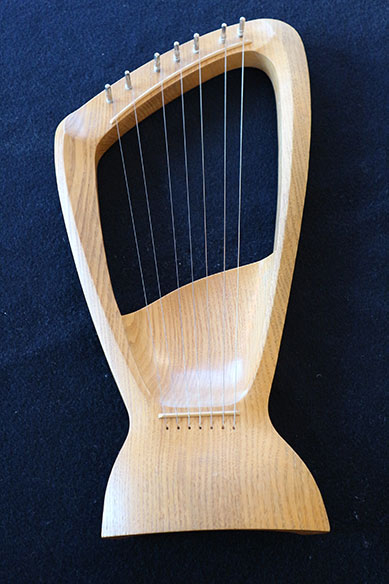
Fig. 1: Children’s harp © Monica Bissegger
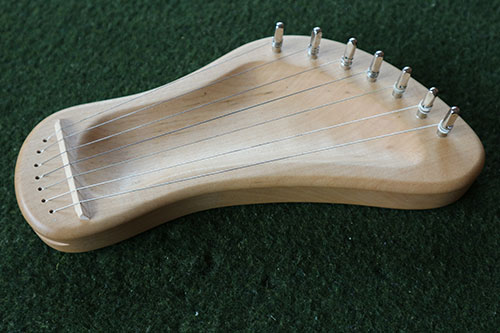
Fig. 2: Fairy harp © Monica Bissegger
Copper bells, cymbals and claves compress sound. The child takes only one cymbal in her hand and touches the therapist’s cymbal with it. Claves are played with the fingers; bigger children play with a mallet.
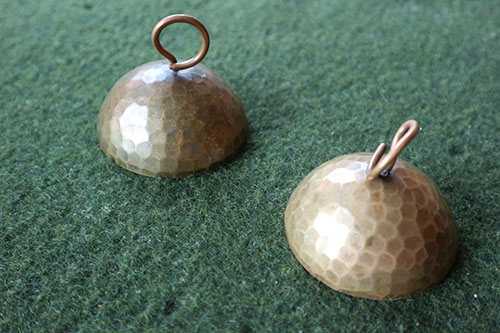
Fig. 3: Copper bell © Monica Bissegger
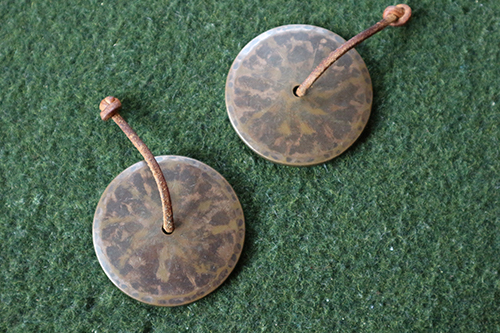
Fig. 4: Cymbals © Monica Bissegger
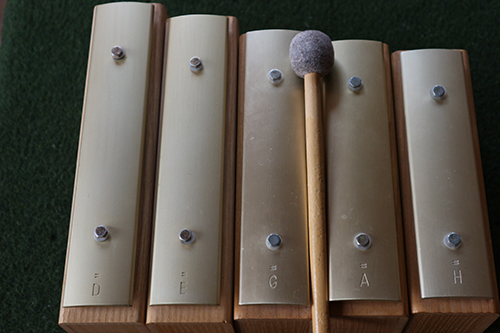
Fig. 5: Claves © Monica Bissegger
Maybe a dwarf will come, or little animals might gather under a tree (on the table). This can be followed by “whispering wood sticks” (carved wooden sticks suspended from a larger wooden stick). Or by a tambourine. We finish with the sounds of bells, English hand bells or copper bells , with an emphasis on listening as much as possible. The sound expands again.
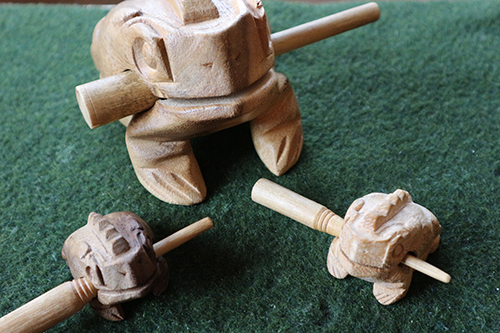
Fig. 6: Frogs © Monica Bissegger
Fig. 7: Tambourine © Monica Bissegger
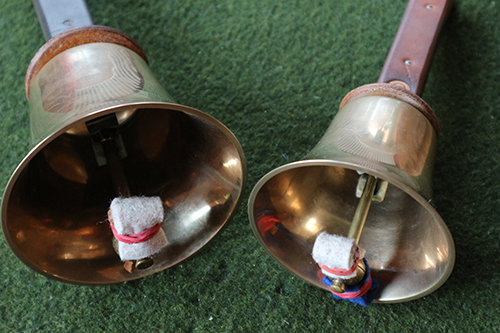
Fig. 8: Hand bells © Monica Bissegger
Our singing voice accompanies the instrumental sounds, more likely hummed for small children, and singing simple songs for the older ones. Our voice is light and enveloping, with elastic tension, and flows along with our breath. The child can be led and accompanied by our singing voice. The child feels perceived. An atmosphere of peace, warmth and security is created. At the same time the child is stimulated to make vocal sounds too. As soon as such sounds come, they need their own space. Only when they are finished do we take them up, integrate and thus mirror them as having been “heard”.
Our speaking is melodious and rhythmic. The less it is needed and the more it can be replaced by musical sounds and our singing voice, the calmer the child becomes.
Music
The music is chosen to suit the small child. It is used to create a space of security. Babies and toddlers are still quite open, but also vulnerable. Sensory impressions have a strong effect, even affecting the child physically. An example of an instrument that can be used to create sounds that are most likely to accommodate small children is the children’s harp, a small stringed (Choroi) instrument (1).
The children’s harp was developed for small children (2). It has an open body. Its sound is peripheral, quiet and fine. Its seven strings are tuned on a pentatonic scale from d’ to e’’ in pure fifths around the central note a’ (d’ – e’ – g’ – a’ – h’ – d’’ – e’’), without half tones. The whole encompasses a double fifth. If the five notes B – E – A – D – G of the circle of fifths are lined up as fifths in descending order, starting from the brightest note of all the root notes (B major, with five sharps), and if the two outer notes b’’ and g are shifted into the one-line octave, a descending tone sequence of e’’ – b’ – a’ – g’ – d’ is produced. If the notes d’ and e’’ are transposed by an octave and the whole thing is played as an ascending tone sequence, d’ – e’ – g’ – a’ – b’ – d’’ – e’’, then these are the notes of the children’s harp.
The pentatonic scale allows us to play motifs and melodies in the “mood of the fifth” (3, 4). The mood of the fifth has a floating, light and atmospheric quality. The oscillation of the tones around a middle tone conveys these qualities. The intervals around the central tone a’ are the same upwards and downwards. This creates an absolute balance, an absolute equilibrium. The double fifth corresponds to the tonal space of a ninth. Here, too, you can experience lightness and the space around. It is not a polarity with a tonic note and an octave that predominates, as with the diatonic scale, but a circling around a middle and thus a unity.
The smaller the child, the simpler we keep the motifs and melodies . For example, we can play a song just with the notes of a fifth (5). The tempo is more likely to be calm, but it can also accelerate a little for a child who is able to walk in order to accommodate his or her joy in movement. Rhythm and the beat are not yet in the foreground. Only moderate use of dynamics and agogics is needed. Inner balance is maintained throughout.
Example patient
Little D. is 1 year and 8 months old. She comes to the clinic with a feeding and eating disorder. At this point she weighs 8 kg. D. only eats certain foods very irregularly and often not at all. Her main food is provided at night with an anti-reflux bottle, distributed over three points in time.
D. was born in the 38th week +5 days of pregnancy by emergency Caesarean section from a cephalic presentation, 2500 g birth weight. Her umbilical cord snapped. Her abdominal wall was closed on her 10th day of life. A heart defect (ventricular septal defect) was operated on when she was 13 months old. As she was not thriving, a stomach tube was placed and removed after the 6th month.
D. is very awake, alert and sociable. She looks very delicate; her gait is a little awkward. She whirls around the music therapy room, briefly touching all the instruments that she can reach. She doesn't want to sit down and always stays in motion. The therapist and the mother sit at a small table. There’s a chair ready for D. The little fairy harps and the copper bell are heard. A little duck is brought in. The tambourine sounds. The bells come last.
At the beginning it seems as if D. is not aware of what the therapist is playing and singing for her. She approaches only briefly, touches an instrument and moves around the perimeter again. The only thing we do together is to put away the small chairs and table. D. is very happy to help.
During the next few sessions, a shared space of sound increasingly develops. D. stops, listens to a sound, makes eye contact and smiles. Then she begins to stop at the small table, pick up an instrument and try it out. She is quick to grasp the sequence of things that will happen in each session. She is becoming more and more interested in putting the instruments in their places on the shelf when it is time to tidy up. Soon she plays each instrument briefly once, standing, and then moves away again. More and more the feeling of doing things together develops and soon after she tries to sit on the small chair and listen and join in.
The therapeutic results: D. was able to gradually become familiar with the situation. She felt more and more comfortable and thus became calmer. The space of sound around her brought her safety and stability. This experience of being “enveloped” in sound seemed to be the decisive point in the therapy. Her losing herself in the periphery could be increasingly replaced by her relating herself to a shared situation. From a newly found sense of inner peace, she could begin her own active playing.
During her two-week inpatient stay, D. regularly received three main meals and, as her treatment progressed, two snacks between meals. It was possible to extend the range of food. In the evening D. got a bottle, no more meals at night. She could increasingly sleep through the night. At mealtimes she sometimes showed very good eating behavior. The quiet atmosphere at the table and the stimulation from the other children clearly increased D.’s interest in food. In addition, she received Solum embrocations, yarrow oil compresses, a heart ointment compress and nutrient baths with rose oil. She also received individual therapy for special needs and eurythmy therapy. D. was discharged into outpatient care in good general condition.
Bibliography
- See also: www.choroi.org
- Laier M, Beilharz G. Kinderharfe spielen. Anregungen für Eltern und Erzieherinnen. Weilheim/Teck: Edition Bingenheim; 2009.
- Steiner R. Das Wesen des Musikalischen und das Tonerlebnis im Menschen. GA 283. 5th ed. Dornach: Rudolf Steiner Verlag; 1989. English translation: Steiner R, Wolsin (ed.). The inner nature of music and the experience of tone. Great Barrington: SteinerBooks; 2015.
- Geipel J. Kurzzeitige Effekte live gespielter pentatonischer Musik auf physiologische und verhaltensbezogene Parameter bei Neugeborenen unter Phototherapie. Master's thesis (Music therapy). SRH University Heidelberg; 2013.
- Ellersiek E. Wiegen- und Ruhelieder in der Quintenstimmung. Stuttgart: Verlag Freies Geistesleben; 2001.